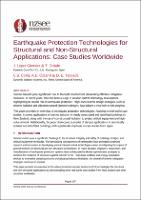| dc.contributor.author | Lopez Gimenez, Javier | |
| dc.contributor.author | Drouin, Thomas | |
| dc.contributor.author | Coria, Camila B. | |
| dc.contributor.author | Ozcanli, Karim Efe | |
| dc.contributor.author | Taboada, Diego | |
| dc.date.accessioned | 2024-07-01T02:01:20Z | |
| dc.date.available | 2024-07-01T02:01:20Z | |
| dc.date.issued | 2024-04-09 | |
| dc.identifier.uri | https://repo.nzsee.org.nz/xmlui/handle/nzsee/2747 | |
| dc.description.abstract | Seismic hazards pose significant risks to the built environment, demanding effective mitigation measures. In recent years, there has been a surge in seismic control technology development, highlighting its crucial role in earthquake protection. High-level seismic design strategies, such as seismic isolation and vibration control (dampers) designs, have played a vital role in this progress.
This paper provides an overview of earthquake protection technologies, focusing on real-world case studies. It covers applications of seismic isolation in newly constructed and retrofitted buildings in New Zealand, along with the use of non-structural isolation to protect critical equipment and high-value artwork. Additionally, the paper showcases examples of damper applications in seismically isolated and retrofitted buildings, with a particular emphasis on case studies from Japan. | |
| dc.language.iso | en | |
| dc.publisher | New Zealand Society for Earthquake Engineering | |
| dc.relation.ispartofseries | 2024;107 | |
| dc.subject | Seismic performance, risk mitigation and resilience of new and existing structures | |
| dc.title | Earthquake Protection Technologies for Structural and Non-Structural Applications: Case Studies Worldwide | |
| dc.type | Article | |

